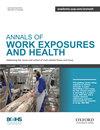29 Survey of occupational hygiene professional practice in spanish-speaking countries
IF 1.8
4区 医学
Q3 PUBLIC, ENVIRONMENTAL & OCCUPATIONAL HEALTH
引用次数: 0
Abstract
Professional credentialing schemes based on experience and examination are used to clarify the scope and required competencies associated with the practice of a profession. To date there is no certification scheme for occupational hygienists in Spanish speaking regions. To fill this void a new credentialing body has been created called the Iberoamerican Board of Occupational Hygiene (JIHO). As a first step to the development of a certification exam for it was necessary to determine the interest in an occupational hygiene certification exam in Spanish and to clarify the most common work practices for those working in the profession. To determine the proper exam weightings for occupational hygiene competencies needed to practice in Spanish-speaking regions JIHO conducted a comprehensive survey of professional practice of occupational hygiene in nations where Spanish is spoken as the primary language. Surveys were sent to 456 practicing occupational hygienists in 9 different countries on a variety of topics. Results indicated that 86% of respondents felt a strong need for an OH certification exam in Spanish. The most frequent and important technical competencies utilized in practice were indicated as 1) awareness about the health effects of hazardous agents to make decisions about workplace activities and worker exposures, and 2) the application of the hierarchy of controls, control banding, hazard communication, training of employees and other methods to reduce worker exposure and workplace risks. The study results have been used to guide the weighting and importance of various technical topics and rubrics on the JIHO exam.29 西班牙语国家职业卫生专业实践调查
以经验和考试为基础的专业资格认证计划用于明确与某一专业相关的执业范围和所需能力。迄今为止,西班牙语地区还没有职业卫生师的认证计划。为了填补这一空白,伊比利亚美洲职业卫生委员会(JIHO)应运而生。作为开发认证考试的第一步,有必要确定西班牙语职业卫生认证考试的兴趣,并明确该行业从业人员最常见的工作实践。为了确定在西班牙语地区执业所需的职业卫生能力的适当考试权重,JIHO 对西班牙语为主要语言的国家的职业卫生专业实践进行了一次全面调查。调查针对 9 个不同国家的 456 名执业职业卫生学家,内容涉及多个主题。结果显示,86% 的受访者认为非常需要西班牙语的职业卫生认证考试。在实践中最常用和最重要的技术能力包括:1)了解有害物质对健康的影响,以便对工作场所的活动和工人接触有害物质的情况做出决策;2)应用分级控制、控制带、危害交流、员工培训和其他方法来减少工人接触有害物质的情况和工作场所的风险。研究结果已被用于指导 JIHO 考试中各种技术主题和评分标准的权重和重要性。
本文章由计算机程序翻译,如有差异,请以英文原文为准。
求助全文
约1分钟内获得全文
求助全文
来源期刊

Annals Of Work Exposures and Health
Medicine-Public Health, Environmental and Occupational Health
CiteScore
4.60
自引率
19.20%
发文量
79
期刊介绍:
About the Journal
Annals of Work Exposures and Health is dedicated to presenting advances in exposure science supporting the recognition, quantification, and control of exposures at work, and epidemiological studies on their effects on human health and well-being. A key question we apply to submission is, "Is this paper going to help readers better understand, quantify, and control conditions at work that adversely or positively affect health and well-being?"
We are interested in high quality scientific research addressing:
the quantification of work exposures, including chemical, biological, physical, biomechanical, and psychosocial, and the elements of work organization giving rise to such exposures;
the relationship between these exposures and the acute and chronic health consequences for those exposed and their families and communities;
populations at special risk of work-related exposures including women, under-represented minorities, immigrants, and other vulnerable groups such as temporary, contingent and informal sector workers;
the effectiveness of interventions addressing exposure and risk including production technologies, work process engineering, and personal protective systems;
policies and management approaches to reduce risk and improve health and well-being among workers, their families or communities;
methodologies and mechanisms that underlie the quantification and/or control of exposure and risk.
There is heavy pressure on space in the journal, and the above interests mean that we do not usually publish papers that simply report local conditions without generalizable results. We are also unlikely to publish reports on human health and well-being without information on the work exposure characteristics giving rise to the effects. We particularly welcome contributions from scientists based in, or addressing conditions in, developing economies that fall within the above scope.
 求助内容:
求助内容: 应助结果提醒方式:
应助结果提醒方式:


